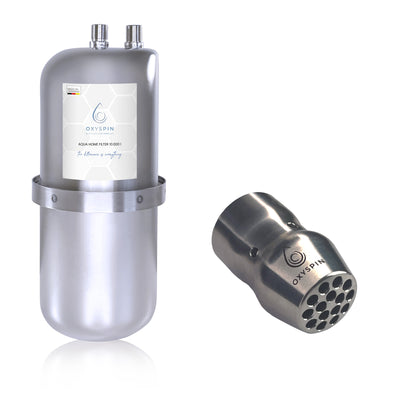YES to structured water with minerals

The QUESTION is circulating...whether minerals in water can be metabolized or not is one of the most discussed questions. Do I need minerals in the water or not? Do these put a strain on my body or not?
two well-known theses:
1. Inorganic minerals cannot be absorbed by the body and put a strain on it. Therefore, the water should not contain any minerals and you should only drink demineralized water. Providers of reverse osmosis systems use this statement to sell their systems.
2. Minerals in water are important and serve as a source of minerals for the body. The mineral water industry uses this statement to promote water with special effects.
However, both statements are only partially correct, since the most important key to a holistic understanding is missing - the biological quality of the water!
Over the last decade it has been found that the body absorbs minerals far better when they are in chelated form. Chelates are minerals surrounded by a ring of amino acids. This is dissolved in the body when it is absorbed and the mineral can be put to use. The amino acids released in the process are organic building blocks and can also be utilized in the body.
The absorption of minerals is problematic if the coupled substances cannot be utilized by the body. Minerals that leave such a residue are referred to as inorganic. It should be noted here that even with equivalent minerals, the quality of the mineral for the metabolism is determined solely by the coupling to a residue that can or cannot be used by the body. Since then, the opinion has often been held that only pure demineralized water is optimally suited for the body, since it cannot metabolize the minerals from the water and these put a strain on the system.
However, recent research confirms that mineral confirmation is controlled by water clusters. If you add this knowledge to the utilization of minerals, a more complex understanding of the interaction of water and minerals arises. Structured water also stores minerals. On the one hand, it takes on the function of an amino acid ring, which means that the mineral is like a chelate for the cell, because the rest is H2O and can be used. On the other hand, the structured water also takes over the electromagnetic oscillations here, strengthens these oscillations, interferes with the natural oscillations and synchronizes the activities in the cell. Minerals are thus included in the resonance behavior. This can also be demonstrated using X-ray absorption methods.
dr medical Gabriel Cousens writes that the possible ion concentration in the water increases with increasing structure. "If structured water is stored around a special ion, as is the case with cell salts, it can move the ions more easily into the even more cytoplasmic water within the cell." The condition of the water therefore plays a role in the usability of the minerals contained in the water the crucial role. In connection with high-energy, highly ordered water with certain frequencies, minerals can also be metabolized accordingly. The body flushes out substances that cannot be used again via this structured water. Therefore, the body can only utilize the minerals from bottled water if this is natural spring water that has been pumped without pressure.
However, this statement should not lead to the assumption that the minerals contained in the water should serve as a source of minerals for the metabolism. But the daily requirement could not be covered in purely mathematical terms. The interaction of water and minerals is more to be understood on a structural level. An empty water without minerals lacks certain vibrations and stable structural possibilities that it needs in order to be able to optimally control the cell functions. In addition, the colloids in the water form the centers for the liquid crystals and keep their structure stable, as Patrick Flanagan found out during his research. For this reason alone, demineralized water is not optimal for our metabolism in the long term and has a destructuring effect on other liquid crystal structures within the system. In addition, demineralized water cannot be easily structured or energized. This was the opinion of the physicist Dr. Barely out. It is therefore advisable when using a reverse osmosis system to carry out remineralization before the water is energized.
The coexistence of water and minerals is mutually dependent and essential for optimal cell function. As is well known, life arose from the sea (water and minerals). Both the characteristic minerals and the resulting crystalline structures make up the specific effect of the water. In the case of so-called healing waters, it was found that the particularly positive effects are due to special electromagnetic frequencies.
Also according to the natural scientist Viktor Schauberger, the minerals give the water its maturity and complete the maturing process of the water. When the water comes into contact with the minerals, it matures and rises on its own. The water learns, so to speak, how to deal with the minerals in order to properly fulfill the metabolism of the food later in the human or animal body.
A non-structured water without minerals can therefore not develop the same healing effect in a holistic sense. However, it can very well stimulate biochemical cleansing processes in the body. However, since the vibration information of the minerals is missing and therefore no stable crystalline structure can be formed, the synchronizing activity of the cell is missing in this process. As a result, useful vital substances can also be washed out in a disadvantageous manner.
Now the question arises, how many minerals do I need in my water? Minerals are character, frequency and flavor carriers in water. Therefore, the question of the amount of minerals is a matter of individual taste. One likes mineral-rich water, the other mineral-poor. In general, it can be stated that a basic amount of at least 100 µs is necessary in the water in order to form structural possibilities in the water and to provide the necessary information content for the cell functions. Anything beyond that is a matter of taste.
Conclusion
1. When it comes to the question of the usability of the minerals, a distinction must be made between the biological quality of the water. This is the only way to decide whether the body can utilize the minerals. The minerals in tap water are not biologically bound and therefore cannot be used by the body. Therefore, tap water needs to be energized rather than filtered. This is the only way the minerals can be used.
2. The minerals in water are not our main source of minerals, but can be metabolized under the right conditions. The taste of natural spring water differs due to its specific mineral content. Therefore, the amount of minerals is a matter of individual taste. However, minerals are important in water so that it can form suitable biological structures. We should therefore not regard the minerals in the water as food for the cells, but rather as the basis for the development of a natural water structure and information capacity. It is therefore advisable to swirl the tap water before drinking it.



